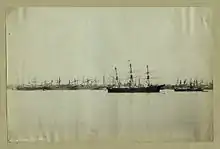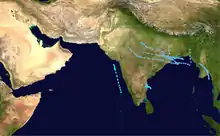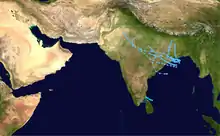Pre-1890 North Indian Ocean cyclone seasons
The years before 1890 featured the pre-1890 North Indian Ocean cyclone seasons. Each season was an ongoing event in the annual cycle of tropical cyclone formation. The North Indian tropical cyclone season has no bounds, but they tend to form between April and December, peaks in May and November. These dates conventionally delimit the period of each year when most tropical cyclones form in the northern Indian Ocean. Below are the most significant cyclones in the time period. Because much of the North Indian coastline is near sea level and prone to flooding, these cyclones can easily kill many with storm surge and flooding. These cyclones are among the deadliest on earth in terms of numbers killed.
| North Indian Ocean cyclone seasons |
Before 18th century
- 1582 – A tropical cyclone impacted the Sundarbans and West Bengal which killed 200,000 people. According to Banglapedia, a five-hour hurricane and thunderstorm destroyed houses and boats in the coast near Bakerganj (presently in Barisal and Patuakhali). Only Hindu temples with a strong foundation were spared.[1]
- 1584 – A tropical cyclone impacted Bangladesh with hurricane-force winds and killed over 2,000,000 people, became deadliest tropical cyclone on record.
- 1688 – A tropical cyclone impacted the Sundarbans and West Bengal.
- 1699 – A tropical cyclone impacted Kolkata and killed 60,000 people.
18th century
- November 13–14, 1721 – A tropical cyclone impacted Madras.
- October 7–12, 1737 – A tropical cyclone impacted the Sundarbans and West Bengal and killed 300,000 people.[2]
- December 1789 – A tropical cyclone impacted Coringa, India and killed 20,000.
Early 19th century
- 1807 – A tropical cyclone impacted West Bengal and killed 90,000 people.
- 1831 – An intense tropical cyclone impacted Odisha.[3]
- 1833 – A tropical cyclone impacted West Bengal and killed around 50,000 people,with a record low of 891 milibar in North Indian Ocean.[4]
- 1847 – A tropical cyclone impacted Bengal where it caused 75,000 deaths and 6000 cattle.[5]
1839 India cyclone
| Rank | Name/Year | Region | Fatalities |
|---|---|---|---|
| 1 | Bhola 1970 | Bangladesh | 500,000 |
| 2 | India 1839 | India | 300,000 |
| 3 | Nina 1975 | China | 229,000 |
| 4 | Bangladesh 1991 | Bangladesh | 138,866 |
| 5 | Nargis 2008 | Myanmar | 138,373 |
| Sources: NOAA, MDR | |||
A tropical cyclone impacted Andhra Pradesh, India on November 25, 1839 and killed around 300,000 people.[6]
Late 19th century
1864 Calcutta Cyclone

On October 5, a powerful cyclone hit near Calcutta, India, killing around 300,100 people.[7] The anemometer in the city was blown away during the cyclone. Over 100 brick homes and tens of thousands of tiled and straw huts were leveled. Most ships in the harbor (172 out of 195) were either damaged or destroyed.[8] The cyclone of 1864 destroyed the ports at Khejuri and Hijli.[9]
November 1867 Great Calcutta cyclone
The anemometer in the city was blown away during the cyclone. A lack of storm surge minimized the overall damage from this system.[8]
October 1874 Bengal cyclone
This severe cyclone killed 80,000 people and caused significant damage.[5]
October 1876 Backergunge cyclone
On October 31, a cyclone hit the Meghna River Delta area of India. The storm surge killed 100,000, and the disease after the storm killed another 100,000.
1877 season

1878 season

1879 season

1880 season

June 1885 Aden cyclone
A cyclone had formed near the Laccadive Islands on May 24, 555 kilometres (345 mi) west of southern India. The SS Mergui encountered the cyclone off the Horn of Africa, 400 kilometres (250 mi) east of Socotra on June 1 and reported it stronger than the tropical cyclone which struck Calcutta in 1864. Just before midnight on the night of June 1, the Diomed reported winds of hurricane force and a pressure of 984 millibars (29.1 inHg). The ship Peshawar reported a westerly hurricane at the east end of the Gulf of Aden towards midnight on the night of June 2. At noon on June 3, the Tantallon reported a pressure of 943 millibars (27.8 inHg) near 12.5N 45.5E. On June 3, the German corvette Augusta, the French dispatch boat Renard, and the British ship SS Speke Hall were lost in the storm in the Gulf of Aden. The system continued westward and shrank in scale as it moved into the entrance of the Red Sea, crossing the coast of Djibouti.[10]
1885 Odisha cyclone
An intense cyclone struck Odisha.[3] it killed one person.
1888 Gujarat Cyclone
On November a violent cyclonic storm with hurricane force winds struck Gujrat causing a ship sunk, killing 1300 people.[11]
See also
- Tropical cyclones and tornadoes in Pakistan
- List of North Indian Ocean cyclone seasons
- List of tropical cyclones that affected India
- List of tropical cyclones
- Tropical cyclone
- Saffir–Simpson scale
- List of Pacific typhoon seasons
- Atlantic hurricane season
- Pacific hurricane season
- List of Australian region cyclones before 1900
- Pre-1900 South Pacific cyclone seasons
- List of South-West Indian Ocean cyclones before 1900
References
- Ain-i-Akbari, Riyaz-Us-Salatin, Bengal District Gazetteer, 24 Parganas-by L.S.S. O'Malley, ICS, 1914, published- by the Bengal SOC Dept.
- "Historical records of 12 most devastating cyclones, which formed in the Bay of Bengal and made landfall on the East coast of India". National Cyclone Risk Mitigation Project. Archived from the original on June 5, 2010. Retrieved May 23, 2020.
- P. Chittibabu; S. K. Dube; J. B. Macnabb; T. S. Murty; A. D. Rao; U. C. Mohanty; P. C. Sinha (February 2004). "Mitigation of Flooding and Cyclone Hazard in Orissa, India". Natural Hazards. 31 (2): 455–485. doi:10.1023/B:NHAZ.0000023362.26409.22. ISSN 0921-030X. S2CID 129718601.
- Longshore, David (2010-05-12). Encyclopedia of Hurricanes, Typhoons, and Cyclones, New Edition. ISBN 9781438118796.
- Dipankar C. Patnaik; N. Sivagnanam (November 2007). "DISASTER VULNERABILITY OF COASTAL STATES: A Short Case Study of Orissa, India". Social Science Research Network: 4. SSRN 1074845. Cite journal requires
|journal=(help) - "The Worst Natural Disasters by Death Toll" (PDF). NOAA. April 6, 2008. Retrieved October 16, 2020.
- Gastrell, J. E.; Henry F. Blanford (1866). Report On The Calcutta Cyclone Of The 5th October 1864. Calcutta: Government Of Bengal. Retrieved 2009-08-15.
- "Calcutta". 1902 Encyclopedia. 2010. Retrieved 2010-04-15.
- "Cyclones and floods at Contai (page 4)". contai.info. Archived from the original on 2011-10-03. Retrieved 2011-08-02.
- David Membery (July 2002). "Monsoon Tropical Cyclones: Part 2". Weather. Royal Meteorological Society. 57 (7): 247–255. Bibcode:2002Wthr...57..246M. doi:10.1256/004316502760195911.
- Template:Website=
General references
- "Cyclone, Hurricane, White squall, Typhoon.". The Cyclopaedia of Indian And Of Eastern And Southern Asia: Commercial, Industrial, and Scientific, 3rd Edition. I. London: Bernard Quaritch. 1885. pp. 866–868. Retrieved 2009-08-15.